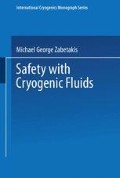Abstract
Basically, safety considerations in the low-temperature laboratory are similar to those in any other laboratory. Each worker must recognize his responsibilities to himself and to those around him. The supervisors and the administrators must recognize their responsibilities to the laboratory worker; each individual must be supplied with the proper tools, instructions, and supervision to permit him to conduct his work in a safe manner. However, a safe operation can only be achieved if each person learns to work safely.
Access this chapter
Tax calculation will be finalised at checkout
Purchases are for personal use only
Preview
Unable to display preview. Download preview PDF.
References
The General Safety Committee of the Manufacturing Chemists Association, Inc., Guide for Safety in the Chemical Laboratory, D. Van Nostrand Co., Inc., New York, 1954, pp. 1–6.
National Safety Council, Accident Prevention Manual for Industrial Operations, National Safety Council, Chicago, 1959, Chapters 1–10.
H. A. J. Pieters and J. W. Creyghton, Safety in the Chemical Laboratory, Academic Press, Inc., New York, 1957, pp. 1–305.
Howard H. Fawcett and William S. Wood, Safety and Accident Prevention in Chemical Operations, John Wiley and Sons, Inc., New York, 1965, pp. 1–617.
Rüssel B. Scott, Cryogenic Engineering, D. Van Nostrand Co., Inc., Princeton, N.J., 1959, pp. 142–214.
Ralph Landau and R. Rosen, Industrial Handling of Fluorine, Ind. Eng. Chem., 39:281–286(1947).
S. G. Turnbull, A. F. Benning, G. W. Feldmann, A. L. Linch, R. C. McHarness, and M. K. Richards, Analysis and Disposal of Fluorine, Ind. Eng. Chem., 39:286–288 (1947).
W. P. Henderson (chairman) et al., The Handling and Storage of Liquid Propellants, U.S. Government Printing Office, Washington, D.C., 1963, pp. 95–108.
Harold W. Schmidt, Reaction of Fluorine With Carbon as a Means of Fluorine Disposal, NACA RM E57E02, NASA, Washington, D.C., 1957, pp. 1–17.
David Burgess and Michael G. Zabetakis, Fire and Explosion Hazards Associated with Liquefied Natural Gas, Bureau of Mines, U.S. Department of the Interior, Report of Investigations 6099, Pittsburgh, 1962, 34 pp.
Joseph Grumer, Margaret E. Harris, and Valeria R. Rowe, Fundamental Flashback, Blowoff, and Yellow-Tip Limits of Fuel Gas-Air Mixtures, Bureau of Mines, U.S. Department of the Interior, Report of Investigations 5225, Pittsburgh, 1956, 199 pp.
Bernard Lewis and Guenther von Elbe, Combustion, Flames and Explosions of Gases, 2nd Ed., Academic Press, Inc., New York, 1961, 731 pp.
J. D. Hajek and E. E. Ludwig, How to Design Safe Flare Stacks, Petro/Chem Engineer, June 1960, pp. C31–C38, July 1960, pp. C44–C51.
A. Roberts, B. R. Pursall, and J. B. Sellers, Methane Layering in Mine Airways, Colliery Guardian, 205:535–541, 588–593, 630–636, 723–732, 756–763 (1962).
Henry E. Perlée, Israel Liebman, and Michael G. Zabetakis, Formation and Flamma-bility of Stratified Methane-Air Mixtures, Bureau of Mines, U.S. Department of the Interior, Report of Investigations 6348, Pittsburgh, 1964, 23 pp.
A. A. Weintraub, Control of Liquid Hydrogen Hazards at Experimental Facilities: A Review, Health and Safety Laboratory, HASL-160, United States Atomic Energy Commission, New York, 1965, pp. 1–249.
CG A, Safe Handling of Compressed Gases, Pamphlet P-l, Compressed Gas Association, New York, 1965, pp. 1–10.
Matheson Gas Data Book, Safe Handling of Compressed Gases in the Laboratory, The Matheson Co., Inc., East Rutherford, N.J., 1961, pp. vii-xiii.
Alanson D. Morehouse II, The Use and Handling of Compressed Gases, U.S. Department of Labor, Bureau of Labor Standards Bulletin No. 259, U.S. Government Printing Office, Washington, D.C., 1963, pp. 1–30.
Fire Hazard Properties of Flammable Liquids, Gases, Volatile Solids, NFP A No. 325M, National Fire Protection Association, Boston, 1965, p. 325M-17.
John H. Foulger, Effects of Toxic Agents, in: Howard H. Fawcett and William S. Wood (editors), Safety and Accident Prevention in Chemical Operations, John Wiley and Sons, New York, 1965, pp. 250–278.
D. M. Liston, Safety Aspects of Site Selection, Plant Layout, and Unit Planning, in: Howard H. Fawcett and William S. Wood (editors), Safety and Accident Prevention in Chemical Operations, John Wiley and Sons, New York, 1965, pp. 35–62.
Richard W. Scott, Safe Electrical Installations in Atmospheres Containing Hydrogen, Chemical Engineering, pp. 79–82, March 2, 1964.
National Fire Codes, Vol. 1, Flammable Liquids; Vol. 2, Gases; Vol. 4, Building Construction and Facilities, Vol. 5, Electrical, Vol. 6, Sprinklers, Fire Pumps, and Water Tanks, Vol. 7, Alarm and Special Extinguishing Systems, Vol. 8, Portable and Manual Fire Control Equipment, Vol. 9, Occupancy Standards and Process Hazards, National Fire Protection Association, Boston, 1964–1965.
Martin Shepherd, Rapid Determination of Small Amounts of Carbon Monoxide, Preliminary Report on the NBS Colorimetric Indicating Gel, Anal. Chem., 19:77–81 (1947).
Infrared Television Catches Rocket-Fuel Leaks, Machine Design, 38:16 (February 17, 1966).
F. A. Loving, Noise-Reducing Structure, U.S. Patent No. 31,165,916, January 1965, E. I. du Pont de Nemours and Co., Explosives Department, Eastern Laboratory, Gibbstown, N.J.
Alphonse Bartkowiak and Joseph M. Kuchta, A Large Spherical Vessel for Combustion Research, Ind. Eng. Chem., Process Design and Development, 5:436–439, (1966).
Author information
Authors and Affiliations
Rights and permissions
Copyright information
© 1967 Springer Science+Business Media New York
About this chapter
Cite this chapter
Zabetakis, M.G. (1967). Laboratory Safety. In: Safety with Cryogenic Fluids. The International Cryogenics Monograph Series. Springer, Boston, MA. https://doi.org/10.1007/978-1-4899-5684-2_5
Download citation
DOI: https://doi.org/10.1007/978-1-4899-5684-2_5
Publisher Name: Springer, Boston, MA
Print ISBN: 978-1-4899-5686-6
Online ISBN: 978-1-4899-5684-2
eBook Packages: Springer Book Archive

